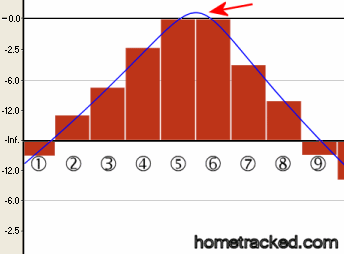- AccurateRip
- Acoustid
- AES/EBU
- AirPlay
- Amplifier
- aptX
- Audio file formats
- ASRC
- AVB
- Bit perfect jitter
- Bits: 16 or 24
- Bit perfect playback
- Bitrate
- Bluetooth
- Burn-in
- BWF
- Cables
- CDtext
- Chromecast
- Clipping
- Clock
- Codec
- Compression
- CRC
- Crossover
- Cue sheet
- DAC
- Damping
- DASH
- Digital
- Digital Room Correction
- Dither
- DLNA
- Drivers
- DoP
- DSP
- EBU R128 (loudness)
- FFT
- FireWire
- Freedb
- Gapless playback
- Generation loss
- HDMI
- Headphone listening
- Hearing
- Hires recording
- Homeplug
- I2S
- ID3
- Inter sample peak
- LDAC
- Linearity (DAC)
- Memory playback
- Music Server
- OCF
- OFC
- PCM
- Perception
- RAID
- ReplayGain
- Ripping
- RFI
- RIAA
- Router
- Sampling, up and over
- Sample Rate Conversion
- Speakers
- S/PDIF
- Storage
- Sync
- Tagging
- Toslink
- Transcoding
- UAA
- Units
- UPnP
- USB
- VST
- WiFi
- WiSA
Inter sample peaks
In an integer world (and digital audio is about integers) there is a minimum and a maximum value an integer can represent.
In case of a unsigned 16 bit integer this is 0 and 65,536.
You can’t store a smaller or bigger number.
In case of a signed integer (16 bit PCM) you get - 32,768 and 32,767
Again you can’t go outside this range.
The loudest signal a DAC can produce (you feed it the highest possible number) is called 0 dBFS. You can’t play louder than that.
The funny thing is it is possible to get signals louder than 0 dBFS from a DAC.
This is because of the inter sample peak.
Each number is converted to an analog signal.
This happens each time step.
The ouput of a DAC (the chip) is analog but it is stepped.
The filters in the output stage of the DAC takes care of smoothing these steps.
If the signal is really hot, this smoothing can cause a value above 0 dBFS so distortion.

A detailed explanation including a sample can be found on Hometracked
When designing Benchmark's new DAC2 HGC D/A converter, we chose to add 3.5 dB of digital headroom to accommodate inter-sample overs. We are working with a 32-bit fixed-point conversion system, and a 32-bit fixed-point gain control. The conversions subsystem has a 133 dB SNR, so we can afford to throw away 3.5 dB SNR to eliminate the clipping of inter-sample overs.
A survey of our in-house music library showed inter-sample overs reaching peak levels of +1.5 to +2 dBFS worst-case. However, please note that our entire library is ripped in lossless formats. I suspect that inter-sample overs could be higher in amplitude, and more frequent, when the audio is reconstructed with an MP3 decoder. Does anyone have test results for MP3 audio sources?
Stop counting samples - Thomas Lund
0 dBFS+ Levels in Digital Mastering - Soren Nielsen, Thomas Lund
Intersample overs in CD recordings - Benchmark Media (2017)

